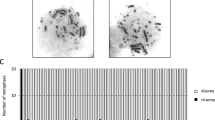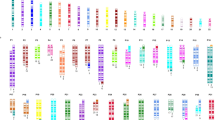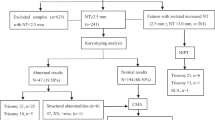Abstract
Neocentromeres are rare functional centromeres formed within noncentromeric chromosomal regions. We report the finding of a neocentromere in a very rare class II analphoid chromosome. This neocentromere was detected prenatally in a fetus with the karyotype: 47,XY,del(4)(p15.3q21.1),+r(4)(p15.3q21.1).ish del(4)(D4S3360+,WHS+,D4Z1−,4qsubtel+),r(4)(D4S3360−,WHS−,D4Z1+,4qsubtel−)de novo. The fetus was missing one normal chromosome 4 but had a ring chromosome, consisting of the pericentromeric region of chromosome 4, and a deleted chromosome 4, the reciprocal product of the ring formation. In situ hybridization established that the chromosome 4 pericentromeric heterochromatin was located on the ring chromosome, while the Wolf-Hirschhorn critical region and chromosome 4 subtelomeric regions were present on the deleted chromosome. A C-band-negative constriction was observed in band 4q21.2 of the deleted chromosome 4, indicating that a neocentromere had been formed in this band, allowing stable segregation during cell division. This chromosome abnormality was detected in cultured amniocytes from a 20-week pregnancy presenting with intrauterine growth retardation and echogenic bowel. The pregnancy resulted in intrauterine death at 33–34 weeks. Despite the apparently balanced karyotype, the fetus is likely to have been phenotypically impaired due to disruption of genes by the neocentromere, rearrangement and ring chromosome formation. There has been one previous report of neocentromere formation in band 4q21; the observation presented here might refine a putative common neocentromeric site to sub-band 4q21.2.
Similar content being viewed by others
Log in or create a free account to read this content
Gain free access to this article, as well as selected content from this journal and more on nature.com
or
References
Choo KH : Domain organization at the centromere and neocentromere. Dev Cell 2001; 1: 165–177.
Warburton PE, Dolled M, Mahmood R et al: Molecular cytogenetic analysis of eight inversion duplications of human chromosome 13q that each contain a neocentromere. Am J Hum Genet 2000; 66: 1794–1806.
Tyler-Smith C, Gimelli G, Giglio S et al: Transmission of a fully functional human neocentromere through three generations. Am J Hum Genet 1999; 64: 1440–1444.
Voullaire L, Saffery R, Earle E et al: Mosaic inv dup (8p) marker chromosome with stable neocentromere suggests neocentromerization is a post-zygotic event. Am J Med Genet 2001; 102: 86–94.
Wandall A, Tranebjaerg L, Tommerup N : A neocentromere on human chromosome 3 without detectable alpha-satellite DNA forms morphologically normal kinetochores. Chromosoma 1998; 107: 359–365.
Lo AW, Craig JM, Saffery R et al: A 330 kb CENP-A binding domain and altered replication timing at a human neocentromere. EMBO J 2001; 20: 2087–2096.
Satinover DL, Vance GH, Van Dyke DL, Schwartz S : Cytogenetic analysis and construction of a BAC contig across a common neocentromeric region from 9p. Chromosoma 2001; 110: 275–283.
Koch J : Neocentromeres and alpha satellite: a proposed structural code for functional human centromere DNA. Hum Mol Genet 2000; 9: 149–154.
Mitelman F (ed) An international system for human cytogenetic nomenclature (ISCN). Basel: S Karger.
Amor DJ, Choo KH : Neocentromeres: role in human disease, evolution, and centromere study. Am J Hum Genet 2002; 71: 695–714.
Grimbacher B, Dutra AS, Holland SM et al: Analphoid marker chromosome in a patient with hyper-IgE syndrome, autism, and mild mental retardation. Genet Med 1999; 1: 213–218.
Reddy KS, Sulcova V, Schwartz S et al: Mosaic tetrasomy 8q: inverted duplication of 8q23.3qter in an analphoid marker. Am J Med Genet 2000; 92: 69–76.
Maraschio P, Tupler R, Rossi E et al: A novel mechanism for the origin of supernumerary marker chromosomes. Hum Genet. 1996; 97: 382–386.
Petit P, Fryns JP : Interstitial deletion 2p accompanied by marker chromosome formation of the deleted segment resulting in a stable acentric marker chromosome. Genet Couns 1997; 8: 341–343.
Voullaire LE, Slater HR, Petrovic V, Choo KH : A functional marker centromere with no detectable alpha-satellite, satellite III, or CENP-B protein: activation of a latent centromere? Am J Hum Genet 1993; 52: 1153–1163.
Slater HR, Nouri S, Earle E, Lo AW, Hale LG, Choo KH : Neocentromere formation in a stable ring 1p32–p36.1 chromosome. J Med Genet 1999; 36: 914–918.
Depinet TW, Zackowski JL, Earnshaw WC et al: Characterization of neo-centromeres in marker chromosomes lacking detectable alpha-satellite DNA. Hum Mol Genet 1997; 6: 1195–1204.
Knegt AC, Li S, Engelen JJ, Bijlsma EK, Warburton PE : Prenatal diagnosis of a karyotypically normal pregnancy in a mother with a supernumerary neocentric 13q21 → 13q22 chromosome and balancing reciprocal deletion. Prenat Diagn 2003; 23: 215–220.
Higgins RR, W E., Baldinger S, Tschider E, Ahmad J, Schwarz S, Curtis CA : Neocentromere in a ring-shaped chromosome 1. Am J Hum Genet Suppl 2000; 67: A775.
Kosztolanyi G : Does ‘ring syndrome’ exist? An analysis of 207 case reports on patients with a ring autosome. Hum Genet 1987; 75: 174–179.
Strehle EM, Ahmed OA, Hameed M, Russell A : The 4q− syndrome. Genet Couns 2001; 12: 327–339.
Hsu TY, Kung FT, Ou CY et al: Prenatal diagnosis of de novo interstitial deletion of proximal 4q by maternal serum screening for Down syndrome. Prenat Diagn 1998; 18: 1323–1327.
Author information
Authors and Affiliations
Corresponding author
Rights and permissions
About this article
Cite this article
Warburton, P., Barwell, J., Splitt, M. et al. Class II neocentromeres: a putative common neocentromere site in band 4q21.2. Eur J Hum Genet 11, 749–753 (2003). https://doi.org/10.1038/sj.ejhg.5201047
Received:
Revised:
Accepted:
Published:
Issue date:
DOI: https://doi.org/10.1038/sj.ejhg.5201047



